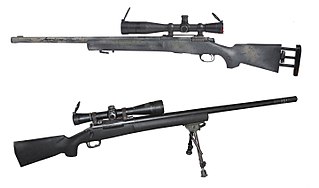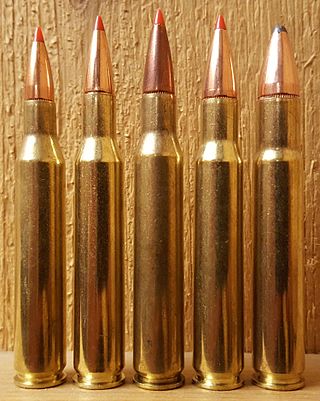
Bolt-action is a type of manual firearm action that is operated by directly manipulating the bolt via a bolt handle, which is most commonly placed on the right-hand side of the weapon.

The Karabiner 98 kurz, often abbreviated Karabiner 98k, Kar98k or K98k and also sometimes incorrectly referred to as a K98, is a bolt-action rifle chambered for the 7.92×57mm Mauser cartridge. It was adopted on 21 June 1935 as the standard service rifle by the German Wehrmacht. It was one of the final developments in the long line of Mauser military rifles.

A sniper rifle is a high-precision, long-range rifle. Requirements include accuracy, reliability, mobility, concealment and optics for anti-personnel, anti-materiel and surveillance uses of the military sniper. The modern sniper rifle is a portable shoulder-fired weapon system with a choice between bolt-action or semi-automatic action, fitted with a telescopic sight for extreme accuracy and chambered for a high-ballistic performance centerfire cartridge.

Weatherby, Inc. is an American gun manufacturer founded in 1945 by Roy Weatherby. The company is best known for its high-powered magnum cartridges, such as the .257 Weatherby Magnum, .270 Weatherby Magnum, .300 Weatherby Magnum, .340 Weatherby Magnum and the .460 Weatherby Magnum. The company's headquarters is based in Sheridan, Wyoming.
The Accuracy International Arctic Warfare rifle is a bolt-action sniper rifle designed and manufactured by the British company Accuracy International. It has proved popular as a civilian, police, and military rifle since its introduction in the 1980s. The rifles have some features that improve performance in very cold conditions without impairing operation in less extreme conditions.
The Winchester Model 70 is a bolt-action sporting rifle. It has an iconic place in American sporting culture and has been held in high regard by shooters since it was introduced in 1936, earning the moniker "The Rifleman's Rifle". The action has some design similarities to Mauser designs and it is a development of the earlier Winchester Model 54, itself based on a Mauser 98-type action.

The .270 Winchester is a rifle cartridge developed by Winchester Repeating Arms Company in 1923 and unveiled in 1925 as a chambering for their bolt-action Model 54 to become arguably the flattest shooting cartridge of its day, only competing with the .300 Holland & Holland Magnum, also introduced in the same year.

The Gewehr 98 is a German bolt-action rifle made by Mauser, firing cartridges from a five-round internal clip-loaded magazine. It was the German service rifle from 1898 to 1935, when it was replaced by the Karabiner 98k, a shorter weapon using the same basic design. The Gewehr 98 action, using a stripper clip loaded with the 7.92×57mm Mauser cartridge, successfully combined and improved several bolt-action engineering concepts which were soon adopted by many other countries, including the United Kingdom, United States, and Japan. The Gewehr 98 replaced the earlier Gewehr 1888 as the main German service rifle. It first saw combat in the Chinese Boxer Rebellion and was the main German infantry service rifle of World War I. The Gewehr 98 saw further military use by the Ottoman Empire and Nationalist Spain.
The Karabiner Modell 1931 is a magazine-fed, straight-pull bolt-action rifle. It was the standard issue rifle of the Swiss armed forces from 1933 until 1958 though examples remained in service into the 1970s. It has a 6-round removable magazine, and is chambered for the 7.5×55mm Swiss Gewehrpatrone 1911 or GP 11, a cartridge with ballistic qualities similar to the 7.62×51mm NATO/.308 Winchester cartridge. Each rifle included a 6-round detachable box magazine with matching stamped serial number. A stripper clip can be used to load the magazine from the top of the receiver.

The .375 H&H Magnum also known as .375 Holland & Holland Magnum is a medium-bore rifle cartridge introduced in 1912 by London based gunmaker Holland & Holland. The .375 H&H cartridge featured a belt to ensure the correct headspace, which otherwise might be unreliable, given the narrow shoulder of the cartridge case. The cartridge was designed to use cordite which was made in long strands – hence the tapered shape of the case, which, as a beneficial side effect also helped in smooth chambering and extraction from a rifle's breech.

The 6mm Remington rifle cartridge, originally introduced in 1955 by Remington Arms Company as the .244 Remington, is based on a necked down .257 Roberts cartridge using a .24/6mm bullet. Known for a combination of high velocity, long range, flat trajectory, and accuracy, it is suitable as a dual use hunting cartridge for both medium-sized big game and varmints. When used in the less common earlier slow twist barrels, it offers exceptional range for varmint applications. While not as commercially popular today as the .243 Winchester, the 6mm Remington enjoys a slight ballistic advantage and continues to be popular with handloaders and custom rifle builders.
The Sako TRG is a bolt-action sniper rifle line designed and manufactured by Finnish firearms manufacturer SAKO of Riihimäki. The TRG-21 and TRG-22 are designed to fire standard .308 Winchester sized cartridges, while the TRG-41 and TRG-42 are designed to fire more powerful and dimensionally larger .300 Winchester Magnum (7.62×67mm) and .338 Lapua Magnum (8.6×70mm) cartridges. They are available with olive drab green, desert tan/coyote brown, dark earth or black stocks, and are also available with a folding stock.

The .244 Holland & Holland Magnum cartridge was created in 1955 in Great Britain by deerstalker and rifle-maker David Lloyd of Pipewell Hall, Northamptonshire and Glencassley in Sutherland, Scotland, and is not to be confused with the smaller-cased and much milder 6 mm Remington. Stalking on extremely steep deer forests such as his own at Glencassley, Lloyd was in search of a "canyon rifle" cartridge that would shoot exceptionally fast and with a very flat trajectory across deep valleys and over distances out to 300 yards (270 m) and more, to make range estimation less critical for accurate bullet placement, and to deliver a hard-hitting bullet weighing a minimum of 100 grains. The .244 H&H Magnum easily met these criteria.
David Llewellyn Lloyd (1910-1996) was an English pilot, deer-stalker, ballistician and sporting rifle maker, of Northamptonshire, England and Glencassley Estate in Sutherland, Scotland.
The CZ-550 is a bolt-action hunting rifle series manufactured by Česká zbrojovka Uherský Brod. The CZ 550 series is available with a medium or magnum sized action. The CZ 550 rifle is based on the Mauser 98 rifle.
The Mauser M 98 are a series of currently (2020) produced bolt-action hunting rifles. The production of the controlled round feed Mauser 98 bolt action system for the German military ceased at the end of World War II in 1945. The new Mauser M 98 and M 98 Magnum rifles for civil users are in production since 1999 in Isny im Allgäu, Germany by Mauser Jagdwaffen GmbH, according to original drawings of 1936 and the respective Mauser patents. Mauser Jagdwaffen GmbH is a subsidiary of SIG Sauer.
The Parker-Hale Model 82 (M82) is the military version of the Parker-Hale 1200TX target rifle; it was accepted for service by several nations for both military and police use. In appearance and design terms the Model 82 is an entirely conventional sniping weapon. It uses a manual bolt action the same as the classic Mauser 98 rifle, allied to a heavy free-floating barrel chambered for the 7.62×51mm NATO round. The barrel weighs 1.98 kg and is manufactured from chrome molybdenum steel. The Model 82 has an integral four-round magazine and an entirely self-contained trigger unit which can be adjusted as required.
The Savage 110 BA is a bolt-action sniper/tactical rifle manufactured by Savage Arms. The rifle is designated with an "LE" code; "Law Enforcement". All 110 BA series rifles are configured with AccuTrigger, matte-blued barreled action, fluted heavy free-floating barrel, muzzle brake, oversized bolt handle, external box magazine, magpul adjustable stock, adjustable pistol grip, and three swivel studs for sling and bipod mounting.

Varmint rifle is an American English term for a small-caliber precision firearm or high-powered airgun primarily used for both varmint hunting and pest control. These tasks include killing three types of pests or nuisance animals that spread diseases or destroy crops or livestock:
The Model 721 and Model 722 along with the later Model 725 variant are bolt-action sporting rifles manufactured by Remington Arms from 1948 until 1961. The 721/722 replaced the short-lived Model 720. The Model 721/722 is considered to be one of the first modern, economically produced sporting rifles whose design largely continued with the subsequent and highly successful Model 700. Manufactured with high precision, it is known for exceptional accuracy. The bolt and receiver design, based on the Mauser action, is considered one of the strongest ever produced. Samples in excellent condition have become collectible.









